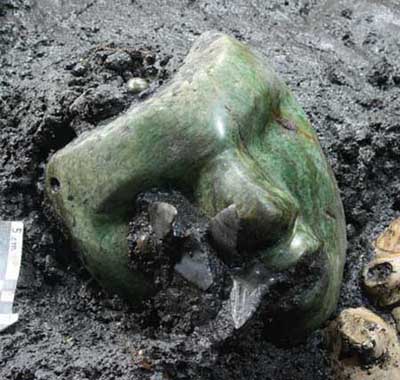Senin, 24 Desember 2012
Kamis, 20 Desember 2012
Mayan Pyramids
The Maya are a people
of southern Mexico and northern Central America (Guatemala, Belize,
western Honduras, and El Salvador) with some 3,000 years of history.
Archaeological evidence shows the Maya started to build ceremonial architecture
approximately 3,000 years ago.
The earliest monuments consisted of
simple burial mounds, the precursors to the spectacular stepped pyramids
from the Terminal Pre-classic period and beyond. These pyramids relied
on intricate carved stone in order to create a stair-stepped design.
Many of these structures featured a top platform upon which a smaller
dedicatory building was constructed, associated with a particular Maya
deity.
Maya pyramid-like structures were also erected to serve as a
place of interment for powerful rulers. Maya pyramid structures occur in
a great variety of forms and functions, bounded by regional and period
differences. The complexity of their celestial alignments, structure
and design baffle archaeologists to this day.
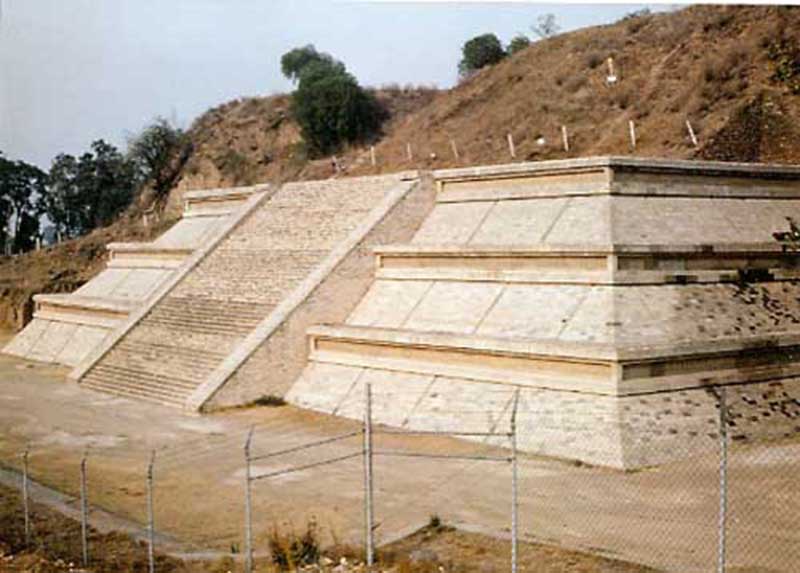
The Great Pyramid of Cholula, also known as Tlachihualtepetl (Nahuatl for "artificial mountain"), is a huge complex located in Cholula, Puebla, Mexico, and is the world's largest monument as well as the largest pyramid by volume.
The temple-pyramid complex was built in four stages, starting from the 3rd century BCE through the 9th century CE, and was dedicated to the deity Quetzalcoatl. It has a base of 450 by 450 m (1476x1476 ft) and a height of 66 m (217 ft). According to the Guinness Book of Records, it is in fact the largest pyramid as well as the largest monument ever constructed anywhere in the world, with a total volume estimated at over 4.45 million m3, even larger than that of the Great Pyramid of Giza in Egypt which is about 2.5 million m3. However the Great Pyramid of Giza is higher at 138.8 m (455 feet). The Aztecs believed that Xelhua built the Great Pyramid of Cholula.
Today the pyramid at first appears to be a natural hill surmounted by a church. This is the Iglesia de Nuestra Se–ora de los Remedios (Church of Our Lady of the Remedies), also known as the Santuario de la Virgen de los Remedios (Sanctuary of the Virgin of the Remedies), which was built by the Spanish in colonial times (1594) on the site of a pre-Hispanic temple. The church is a major Catholic pilgrimage destination, and the site is also used for the celebration of indigenous rites. Many ancient sites in Latin America are found under modern Catholic holy sites, due to the practice of the Catholic Church repurposing local religious sites.
Because of the historic and religious significance of the church, which is a designated colonial monument, the pyramid as a whole has not been excavated and restored, as have the smaller but better-known pyramids at Teotihuacan. Inside the pyramid are some five miles (8 km) of tunnels excavated by archaeologists.
Chichen Itza
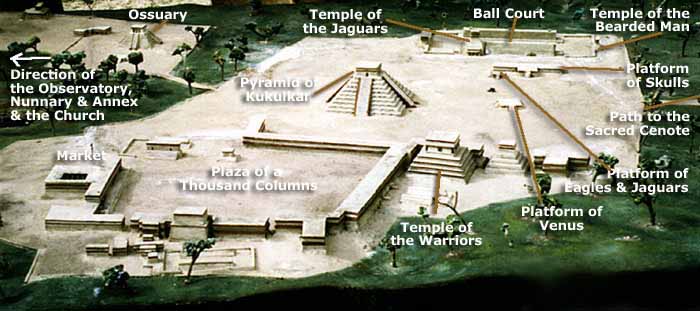
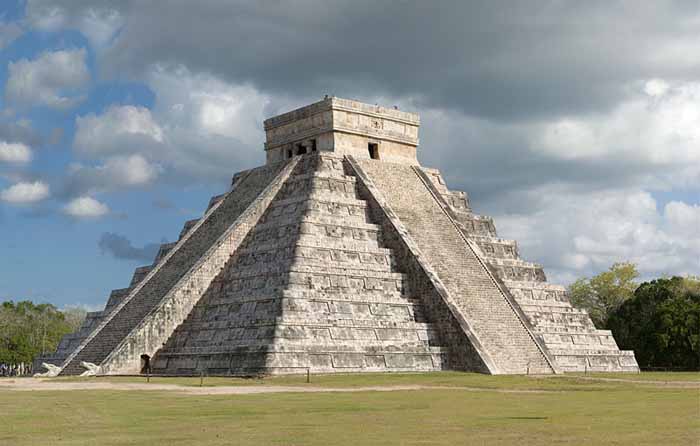
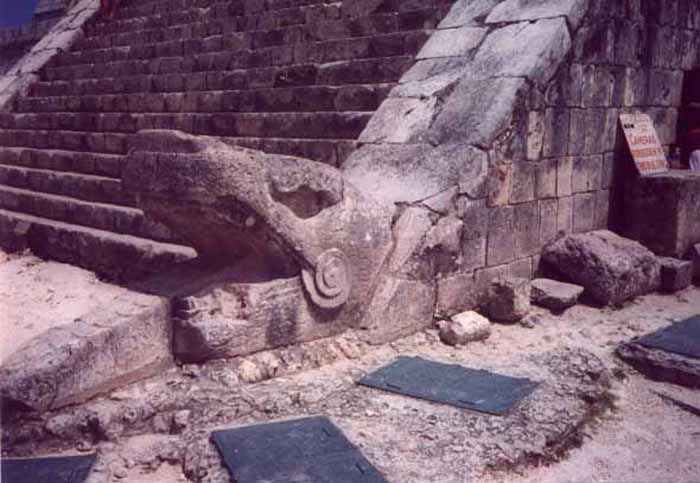
Mesoamerican cultures periodically built larger pyramids atop older ones, and this is one such example. In the mid 1930s, the Mexican government sponsored an excavation of El Castillo. After several false starts, they discovered a staircase under the north side of the pyramid.
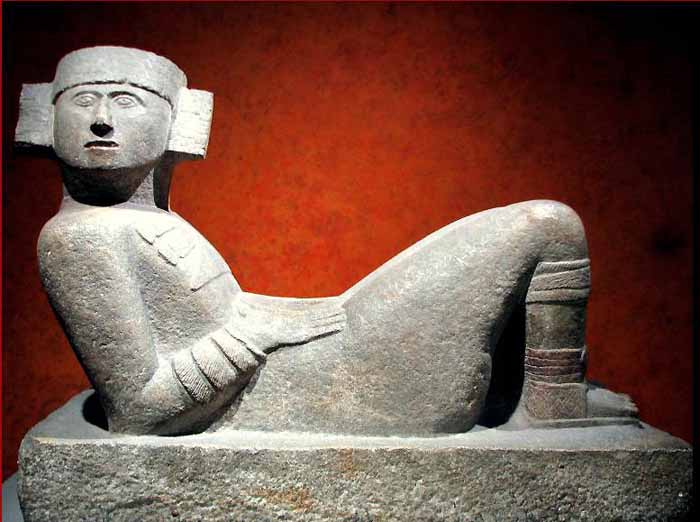
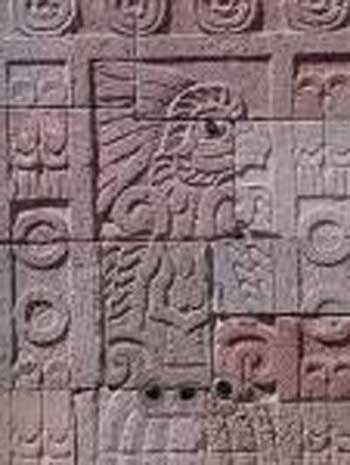 A Mayan glyph shows Kukulkan/Quetzalcoatl the
A Mayan glyph shows Kukulkan/Quetzalcoatl the plumed serpent with a gigantic Quetzal bird behind him.
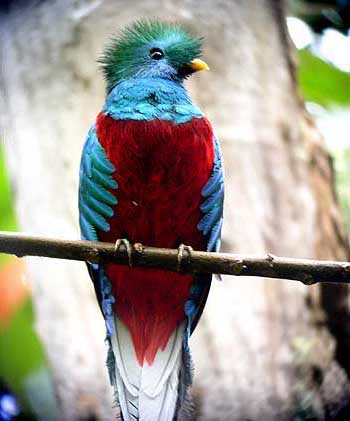
Quetzalcoatl
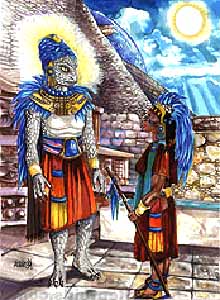
The dimensions of the steps are the key to the effect. Each step is tall, but the tread, where the foot is placed, doesn't cut deeply into the pyramid. If the stairs were deeper and not so high, the effect on the echoes would not be as great, and they wouldn't sound like a chirp.
In the millennium since this pyramid was built, though the plaster has eroded from the limestone staircases, the sound is still recognizable. Today the Quetzal still plays an important role in modern Mayan culture. The Quetzal is the unit of currency in Guatemala. The Guatemalan government issues a prestigious award named "The Order of the Quetzal."
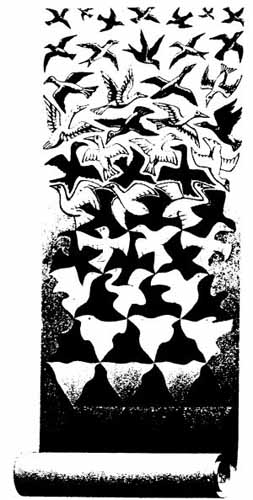
Language of the Birds - God Language
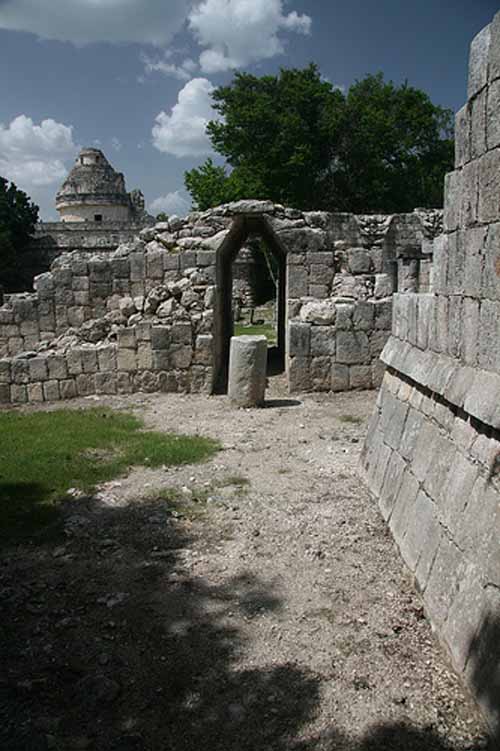
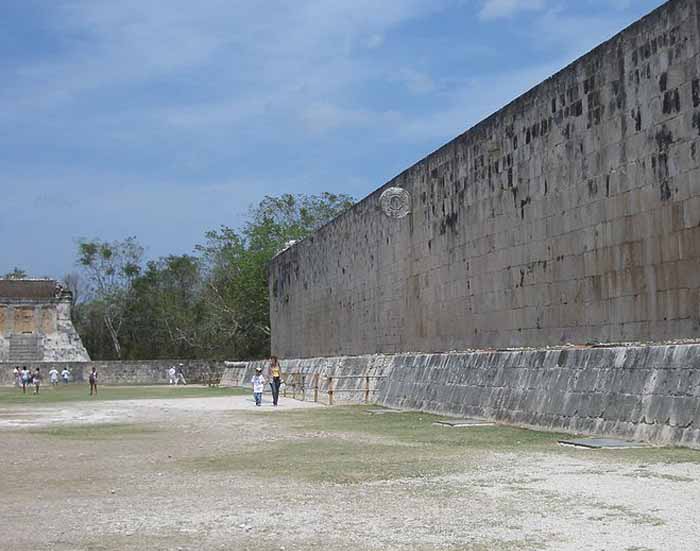
Stone Ring located 9 m (30 ft) above the floor of the Great Ballcourt, Chichen Itza
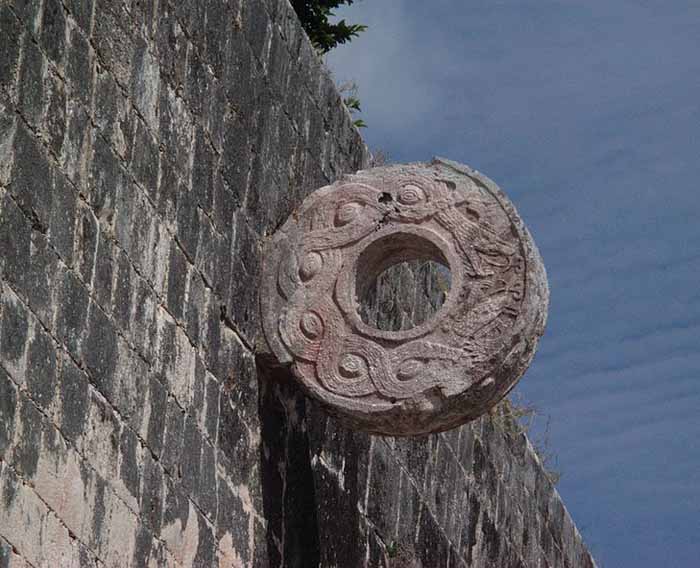
At the base of the high interior walls are slanted benches with sculpted panels of teams of ball players. In one panel, one of the players has been decapitated and from the wound emits seven streams of blood; six become wriggling serpents and the center becomes a winding plant.
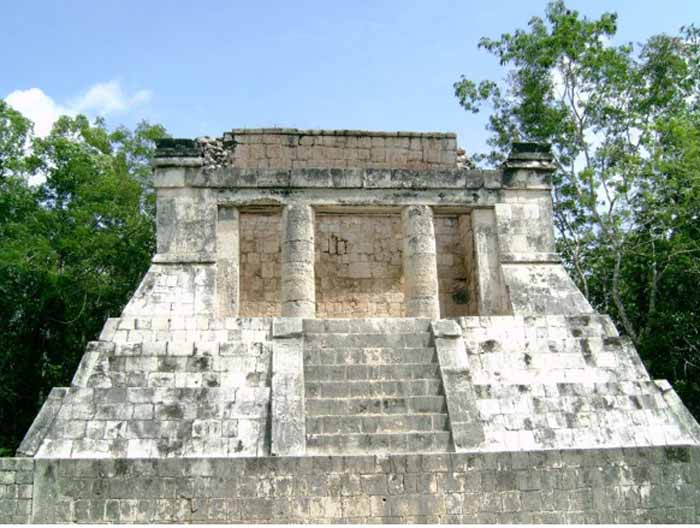
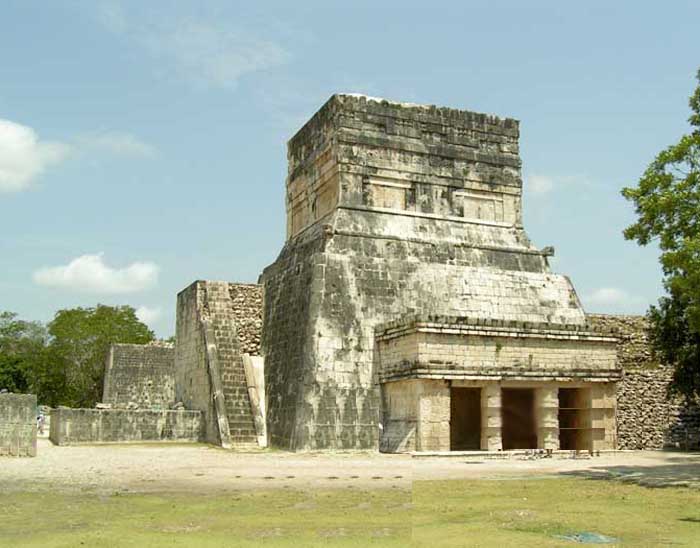

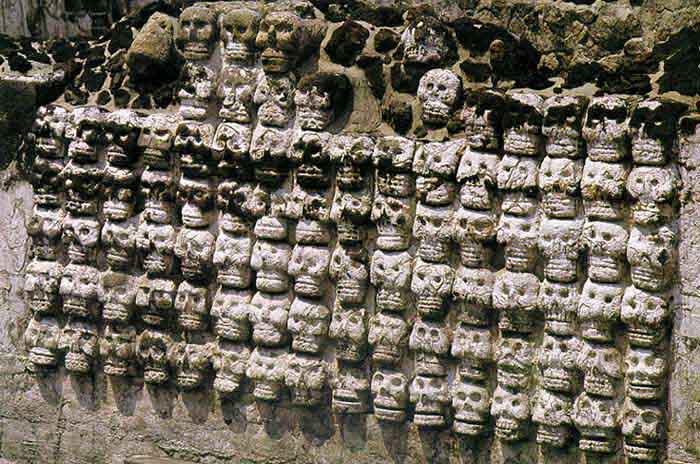
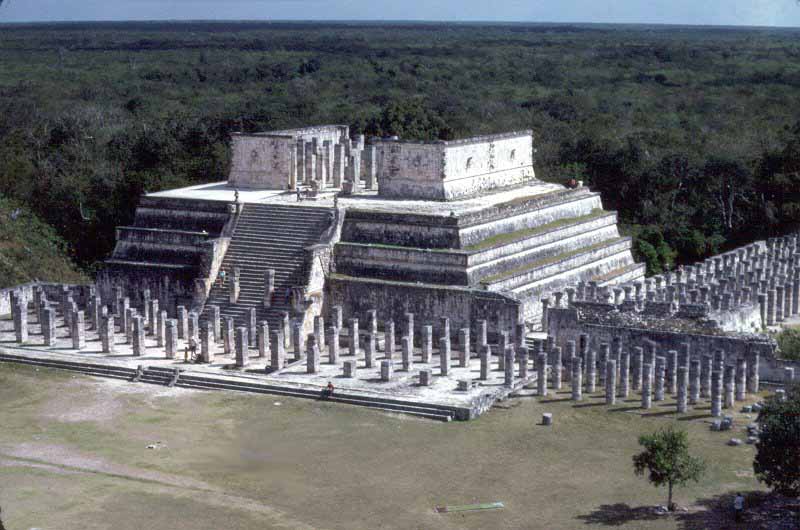

The Temple of the Warriors complex consists of a large stepped pyramid fronted and flanked by rows of carved columns depicting warriors. This complex is analogous to Temple B at the Toltec capital of Tula, and indicates some form of cultural contact between the two regions. The one at Chichen Itza, however, was constructed on a larger scale.
At the top of the stairway on the pyramid's summit (and leading towards the entrance of the pyramid's temple) is a Chac Mool. This temple encases or entombs a former structure called The Temple of the Chac Mool.
Along the south wall of the Temple of Warriors are a series of what are today exposed columns, although when the city was inhabited these would have supported an extensive roof system. The columns are in three distinct sections: an east group, that extends the lines of the front of the Temple of Warriors; a north group, which runs along the south wall of the Temple of Warriors and contains pillars with carvings of soldiers in bas-relief; and a northeast group, which was apparently formed a small temple at the southeast corner of the Temple of Warriors, which contains a rectangular decorated with carvings of people or gods, as well as animals and serpents. The northeast column temple also covers a small marvel of engineering, a channel that funnels all the rainwater from the complex some 40 metres (130 ft) away to a rejollada, a former cenote.
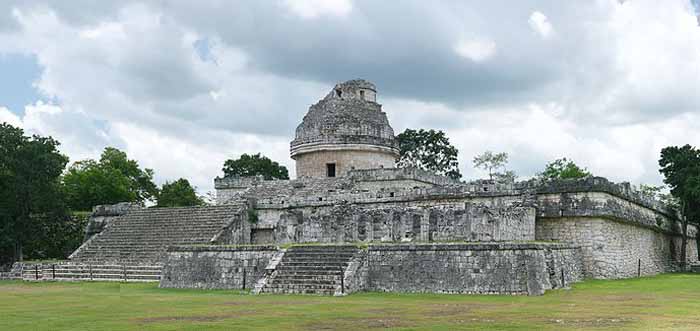
Pyramids of the Sun and Moon in Teotihuacan
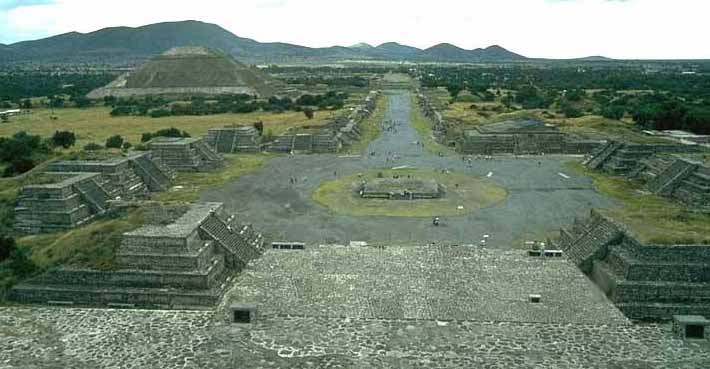
City Plan
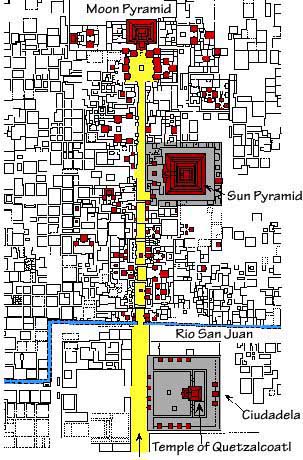
Teotihuacan was,
at its height in the first half of the 1st millennium BCE, the largest
pre-Columbian city in the Americas. The city during its existence was
larger than any European city of the same era, possibly including Rome.
The civilization and cultural complex associated with the site is also
referred to as Teotihuacan. Its influence spread throughout Mesoamerica;
evidence of Teotihuacano presence, if not outright political and
economic control, can be seen at numerous sites in Veracruz and the Maya
region. The city was located in what is now the San Juan Teotihuacan
municipality in the State of Mexico, Mexico, approximately 40 km (24.8
mi) northeast of Mexico City. It covers a total surface area of 83 kms
and was made a UNESCO World Heritage Site in 1987.
The early history of Teotihuacan is quite mysterious, and the origin of
its founders is debated. For many years, archaeologists believed it was
built by the Toltec. This belief was based on colonial period texts such
as the Florentine Codex which attributed the site to the Toltecs.
However, the Nahuatl word "Toltec" generally means "craftsman of the
highest level" and may not always refer to the archaeological Toltec
civilization centered at Tula, Hidalgo. Since Toltec civilization
flourished centuries after Teotihuacan, they cannot be understood as the
city's founders.
In the Late Formative period, a number of urban centers arose in central
Mexico. The most prominent of these appears to have been Cuicuilco, on
the southern shore of Lake Texcoco. Scholars have speculated that the
eruption of the Xitle volcano may have prompted a mass emigration out of
the central valley and into the Teotihuacan valley. These settlers may
have founded and/or accelerated the growth of Teotihuacan.
Other scholars have put forth the Totonac people as the founders of
Teotihuacan, and the debate continues to this day. There is evidence
that at least some of the people living in Teotihuacan came from areas
influenced by the Tiwanaku Civilization, including the Zapotec, Mixtec and Maya peoples.
Sun Gate of Tiwanaku
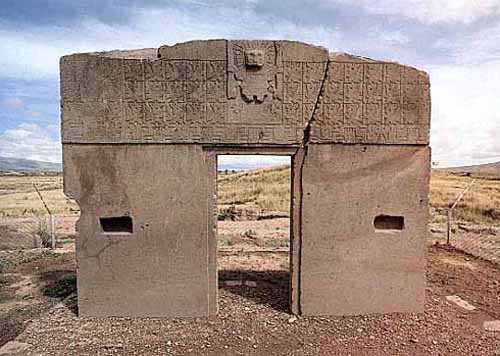
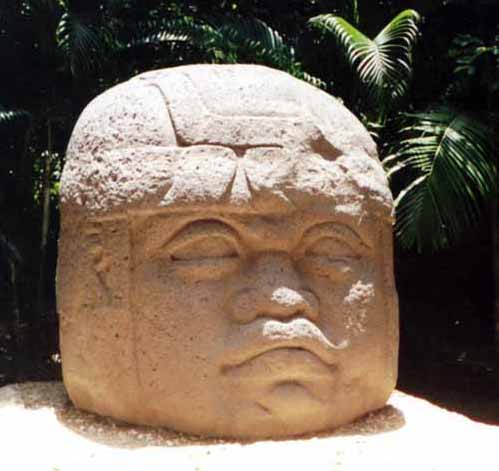
who are considered to be the Mother Civilization of Mesoamerica.
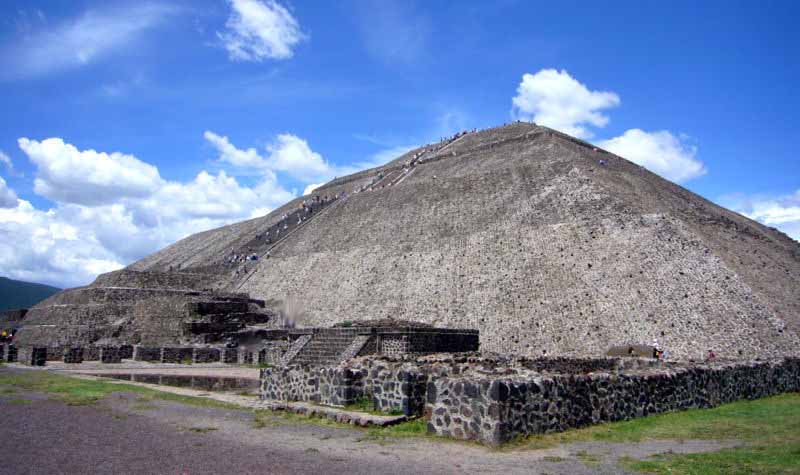
The earliest buildings at Teotihuacan date to about 200 BCE. The Pyramid of the Sun,
was completed by 100 BCE. It is the largest building in Teotihuacan and
one of the largest in Mesoamerica. Found along the Avenue of the Dead,
in between the Pyramid of the Moon and the Ciudadela, and in the shadow
of the massive mountain Cerro Gordo, the pyramid is part of a large
complex in the heart of the city.
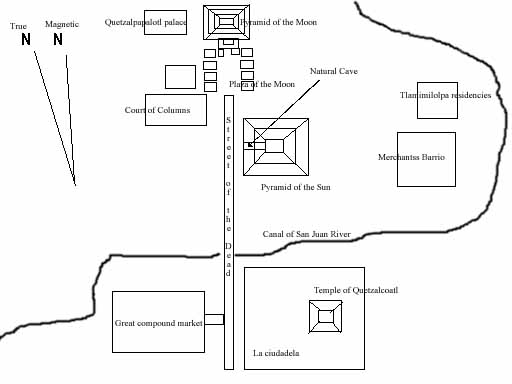
The name "Pyramid of the Sun" comes from the Aztecs,
who visited the city of Teotihuacan centuries after it was abandoned;
the name given to the pyramid by the Teotihuacanos. It was constructed
in two phases. The first construction stage, around 100 A.D., brought
the pyramid to nearly the size it is today.
The second round of construction resulted in its completed size of 738
feet (225 meters) across and 246 feet (75 meters) high, making it the
third largest pyramid in the world behind the Great Pyramid of Cholula
and The Great Pyramid.
The second phase also saw the construction of an altar atop of the
pyramid, which has not survived into modern times. The Adosada platform
was added to the pyramid in the early third century, at around the same
time that the Ciudadela and Temple of the Feathered Serpent, (see below)
Teotihuacan Pyramid of the Feathered Serpent were constructed.
Over the structure the ancient Teotihuacanos finished their pyramid with
lime plaster imported from surrounding areas, on which they painted
brilliantly colored murals. While the pyramid has endured for centuries,
the paint and plaster have not and are no longer visible. Few images
are thought to have been included in the mural decorations on the sides
of the pyramid. Jaguar heads and paws, stars, and snake rattles are
among the few images associated with the pyramids.
It is thought that the pyramid venerated a deity within Teotihuacan
society but the destruction of the temple on top of the pyramid, by both
deliberate and natural forces prior to the archaeological study of the
site, has so far prevented identification of the pyramid with any
particular deity. Some scholars have suggested that the deity of the
pyramid was the Great Goddess, one of two major Teotihuacan deities and
one of the few goddesses in ancient Mesoamerica. However, little
evidence exists to support this theory.
Modern investigations
The first major archaeological excavation of the site was done by
Leopoldo Batres in 1906. Batres supervised restoration of the Pyramid
for the 1910 centennial of Mexican independence. Some aspects of Batres'
reconstruction of the pyramid have been questioned by later
archaeologists. Subsequent excavations of Teotihuacan have continued to
the present. In 1925 Pedro Dosal discovered skeletons at the 4 corners
of the foundations of the temple, which he interpreted as human
sacrifices at the dedication of the temple.
Structure location and orientation
The orientation of the structure may hold some anthropological
significance. The pyramid is oriented slightly northwest of the horizon
point of the setting sun on two days a year, August 12 and April 29,
which are about one divinatory calendar year apart for the
Teotihuacanos. The day of August 12 is significant because it would have
marked the date of the beginning of the present era and the initial day
of the Maya long count calendar. In addition, many important
astrological events can be viewed from the location of the pyramid that
are important in terms of both agriculture and belief systems of the
ancient society.
The pyramid was built over a man-made tunnel leading to a "cave" located
six meters down beneath the center of the structure. Originally this
was believed to be a naturally formed lava tube cave and interpreted as
possibly the place of Chicomoztoc, the place of human origin according
to Nahua legends. More recent excavations have suggested that the space
is man-made instead, and could have served as a royal tomb. In 2008
scientists used muon detectors to try to find other chambers within the
interior of the pyramid, but substantial looting has prevented the
discovery of a function for the chambers in Teotihuacan society.
Recovered artifacts
Only a few caches of artifacts have been found in and around the
pyramid. Obsidian arrowheads and human figurines have been discovered
inside the pyramid and similar objects have been found at the nearby
Pyramid of the Moon and Pyramid of the Feathered Serpent in the
Ciudadela. These objects may have represented sacrificial victims. In
addition, burial sites of children have been found in excavations at the
corners of the pyramid. It is believed that these burials were part of a
sacrificial ritual dedicating the building of the pyramid.
Original offering found at Teotihuacan pyramid PhysOrg - December 14, 2011
Archaeologists announced Tuesday that they dug to the very core of Mexico's tallest pyramid and found what may be the original ceremonial offering placed on the site of the Pyramid of the Sun before construction began. The offerings found at the base of the pyramid in the Teotihuacan ruin site just north of Mexico City include a green serpentine stone mask so delicately carved and detailed that archaeologists believe it may have been a portrait. The find also includes 11 ceremonial clay pots dedicated to a rain god similar to Tlaloc, who was still worshipped in the area 1,500 years later, according to a statement by the National Institute of Anthropology and History, or INAH.
Ornaments
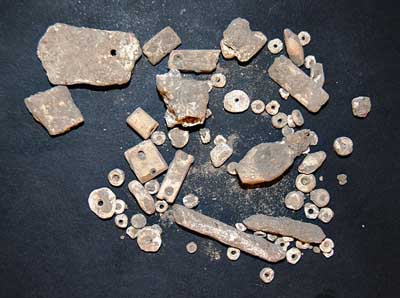

Archaeologists in Mexico have uncovered a small treasure trove of items
that may have been placed as offerings to mark the start of construction
on the Teotihuacan Pyramid of the Sun almost 2,000 years ago. The
offerings include pieces of obsidian and pottery as well as animal
remains. Perhaps most striking are three human figurines made out of a
green stone, one of which is a serpentine mask that researchers think
may have been a portrait.
17 Images of the Excavation Site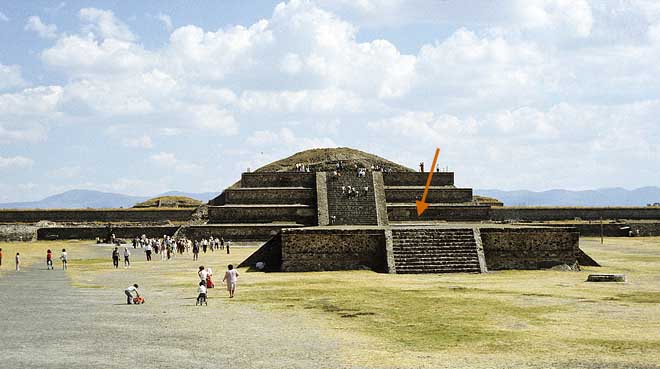
The location of the excavation site between the Feathered Serpent Temple and the platform in front of it (Structure IC).
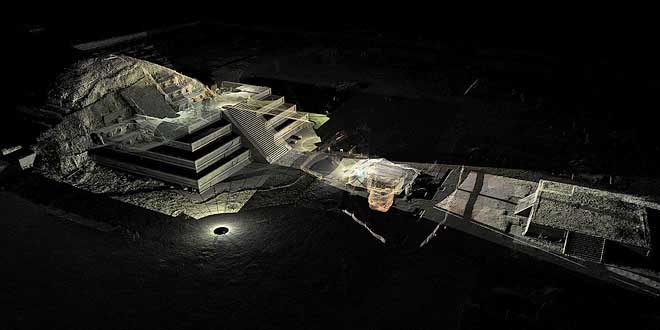
Vertical shaft in front of the Feathered Serpent Temple.

Kamis, 16 Agustus 2012
Macam Bentuk Ketupat
Ketupat adalah makanan populer Indonesia dengan bahan dasar beras yang
direbus matang di dalam selongsong anyaman daun kelapa muda atau janur.
Tidak semua orang dapat membuat selongsong ketupat, karena diperlukan
ketrampilan dan pengalaman tersendiri.
Mungkin Anda hanya mengenal beberapa jenis bentuk ketupat saja yang biasa dinikmati ketika Lebaran. Ada beberapa ketupat untuk hiasan dalam bentuk yang menarik seperti Ketupat Bentuk Lontong, Ketupat Bentuk Balok, Ketupat Lebaran, Ketupat Tabung/Guling, Ketupat Dada Ayam, Ketupat Kodok, Ketupat Kapak, Ketupat Bantal, Ketupat Sudut Tidak Beraturan, Ketupat Sudut Lancip, Ketupat Patung Hewan, Ketupat Sudut Tumpul, Ketupat Model Saku, Ketupat Bentuk Bintang, Ketupat Bentuk Unggas, dan Ketupat Bentuk Nanas.  |
| Bentuk Kubus |
 |
| Ketupat Sate |
 | |
| Ketupat Burung |
 |
| Ketupat Pedal |
 |
| Ketupat Kucing |
 |
| Ketupat Siput |
 |
| Ketupat Jantung Hati |
 |
| Ketupat Bebek |
 |
| Ketupat Ikan |




Rabu, 13 Juni 2012
Mensiasati Rumah Type 33
Tak jarang, terbatasnya luas rumah type 33 justru menantang pemilik rumah
mendesain hunian mungilnya secara lebih kreatif. Hingga kini rumah bercorak modern minimalis masih digemari masyarakat.
Rumah seperti ini menjadi jawaban atas kebutuhan masyarakat yang
menginginkan rumah yang simpel namun fungsinya bisa maksimal. Selain
itu, rumah modern minimalis juga menjadi solusi atas terbatasnya lahan, utamanya di kota-kota besar. Dengan corak rumah seperti ini, maka fungsi ruang bisa dimaksimalkan.
Namun rumah berciri modern minimalis membutuhkan sentuhan dan penataan yang berbeda, terutama dalam hal perencanaan dan penataan interior disain. Ini penting agar kesan lapang masih tetap bisa dirasakan meskipun luas ruangan terbatas.
Ada banyak cara menyiasati desain rumah mungil, tapi setidaknya beberapa poin berikut ini penting dijadikan pegangan untuk Anda.
Dimensi
Dimensi atau ukuran adalah hal pertama yang terpikirkan saat menata rumah mungil. Antara ukuran dan besaran furnitur harus disesuaikan dengan ruang.
Selain harus proporsional, furnitur sebaiknya disesuaikan dengan jumlah penghuni. Pemilihan furnitur tepat akan menciptakan ruang lapang beserta sirkulasi udara yang baik.
Dalam memanfaatkan ukuran, pertimbangkan secara optimal setiap jengkalnya. Jangan sampai Anda membuat ruang dengan potensi menjadi sudut mati dan tempat tumpukan barang.
Untuk menyiasati masalah seperti ini, buatlah furnitur built in dengan ukuran pas dan sesuai dengan spot-spot dalam rumah.
Simpel
Tatanan ruang paling tepat untuk rumah mungil adalah simpel, minimalis, minim corak, dan dibalut warna terang. Pilihan ini akan memberi kesan lapang pada hunian.
Pilihlah warna-warna terang seperti putih dan pastel untuk bidang-bidang besar seperti lantai, dinding, plafon, serta furnitur utama. Kombinasi banyak warna sebaiknya Anda hindari, tetapi gunakan sedikit aksen untuk mempermanis ruangan.
Menghadirkan dekorasi dinding dalam corak ramai, furnitur masif, serta penggunaan warna gelap membawa kesan sesak pada ruangan. Menghadirkan tatanan interior mewah dan elegan untuk rumah mungil bukanlah hal bijak, karena hal itu justru akan memberi kesan ruangan semakin sumpek.
Tanpa sekat
Dalam sebuah rumah mungil, ada baiknya Anda mengurangi aplikasi dinding atau partisi masif sebagai pembatas dan pemisah ruang. Sebaiknya, rancanglah layout ruang dengan pendekatan open plan atau tanpa sekat. Cara ini akan menciptakan kesan ruangan lebih luas daripada ukuran sebenarnya.
Pemisahan ruangan dengan konsep tanpa sekat bisa dilakukan dengan cara menciptakan zona pada area berbeda. Konsep tanpa sekat ini bisa memberi keleluasaan pada fungsi ruang serta menciptakan rasa ruang lebih luas secara visual. Jika diperlukan, ruang tetap dapat diberi pembatas, misalnya partisi kaca tembus pandang atau rak buku.
Manipulasi ruang
Dengan menggunakan beberapa teknik pendekatan desain, Anda dapat memanipulasi ruang di dalam rumah mungil menjadi lebih besar, lebih tinggi atau lebih lebar. Caranya adalah memanfaatkan ruang luar sebagai bagian dari interior ruang, atau memanfaatkan teras belakang rumah sebagai area perluasan ruang makan atau ruang keluarga Anda.
Alternatif cara lainnya adalah menggunakan kaca sebagai pembatas ruang yang menghadap ke area luar. Hal ini akan menciptakan perluasan ruang secara visual.
Anda juga dapat memanfaatkan bidang refleksi seperti cermin untuk menghadirkan kesan ruangan lebih luas. Sekecil apapun bidang refleksi, pantulan yang tercipta akan menambah volume ruang dalam tampilan visual.
Efisien dan fleksibel
Salah satu keberhasilan merancang rumah mungil adalah dengan meningkatkan efisiensi ruang. Caranya, pertimbangkan aspek fleksibilitas kala merancang fungsi ruang. Terapkan konsep ruang bersama atau multifungsi untuk memenuhi fleksibilitas ruang tersebut.
Penggunaan furnitur sebaiknya didesain sesuai kebutuhan Anda serta harus diperlakukan sebagai elemen penting dalam desain. Penggunaan konsep furnitur multifungsi merupakan solusi cermat untuk menghemat tempat sekaligus area penyimpanan. Tempat penyimpanan bisa terintegrasi dengan tempat duduk, sofa, bed, bahkan tangga.
Cahaya
 Faktor
cahaya, terutama cahaya matahari, merupakan elemen penting untuk rumah
berukuran mungil. Bukaan sekecil apapun akan besar pengaruhnya bagi
rumah mungil. Untuk itu, manfaatkan keberadaan jendela dan skylight untuk memasukkan cahaya matahari ke dalam ruangan secara maksimal.
Faktor
cahaya, terutama cahaya matahari, merupakan elemen penting untuk rumah
berukuran mungil. Bukaan sekecil apapun akan besar pengaruhnya bagi
rumah mungil. Untuk itu, manfaatkan keberadaan jendela dan skylight untuk memasukkan cahaya matahari ke dalam ruangan secara maksimal.
Namun demikian, Anda patut memperhatikan bentuk, jenis, serta ukuran jendela. Bidang bukaan besar akan memberi rasa ruangan lebih luas dari kondisi sebenarnya.
Selain matahari, penerangan buatan juga penting untuk menciptakan penataan yang cermat. Dalam menciptakan pencahayaan buatan, Anda harus menyesuaikannya secara efisiensi dan jenis lampunya.
Furnitur
Pilihan furnitur perlu dipilih yang berpengaruh kuat pada sentuhan estika yang memberikan kesan lapang, nyaman dan ergodinamik
Namun rumah berciri modern minimalis membutuhkan sentuhan dan penataan yang berbeda, terutama dalam hal perencanaan dan penataan interior disain. Ini penting agar kesan lapang masih tetap bisa dirasakan meskipun luas ruangan terbatas.
Ada banyak cara menyiasati desain rumah mungil, tapi setidaknya beberapa poin berikut ini penting dijadikan pegangan untuk Anda.
Dimensi
Dimensi atau ukuran adalah hal pertama yang terpikirkan saat menata rumah mungil. Antara ukuran dan besaran furnitur harus disesuaikan dengan ruang.
Selain harus proporsional, furnitur sebaiknya disesuaikan dengan jumlah penghuni. Pemilihan furnitur tepat akan menciptakan ruang lapang beserta sirkulasi udara yang baik.
Dalam memanfaatkan ukuran, pertimbangkan secara optimal setiap jengkalnya. Jangan sampai Anda membuat ruang dengan potensi menjadi sudut mati dan tempat tumpukan barang.
Untuk menyiasati masalah seperti ini, buatlah furnitur built in dengan ukuran pas dan sesuai dengan spot-spot dalam rumah.
Simpel
Tatanan ruang paling tepat untuk rumah mungil adalah simpel, minimalis, minim corak, dan dibalut warna terang. Pilihan ini akan memberi kesan lapang pada hunian.
Pilihlah warna-warna terang seperti putih dan pastel untuk bidang-bidang besar seperti lantai, dinding, plafon, serta furnitur utama. Kombinasi banyak warna sebaiknya Anda hindari, tetapi gunakan sedikit aksen untuk mempermanis ruangan.
Menghadirkan dekorasi dinding dalam corak ramai, furnitur masif, serta penggunaan warna gelap membawa kesan sesak pada ruangan. Menghadirkan tatanan interior mewah dan elegan untuk rumah mungil bukanlah hal bijak, karena hal itu justru akan memberi kesan ruangan semakin sumpek.
Tanpa sekat
Dalam sebuah rumah mungil, ada baiknya Anda mengurangi aplikasi dinding atau partisi masif sebagai pembatas dan pemisah ruang. Sebaiknya, rancanglah layout ruang dengan pendekatan open plan atau tanpa sekat. Cara ini akan menciptakan kesan ruangan lebih luas daripada ukuran sebenarnya.
Pemisahan ruangan dengan konsep tanpa sekat bisa dilakukan dengan cara menciptakan zona pada area berbeda. Konsep tanpa sekat ini bisa memberi keleluasaan pada fungsi ruang serta menciptakan rasa ruang lebih luas secara visual. Jika diperlukan, ruang tetap dapat diberi pembatas, misalnya partisi kaca tembus pandang atau rak buku.
Manipulasi ruang
Dengan menggunakan beberapa teknik pendekatan desain, Anda dapat memanipulasi ruang di dalam rumah mungil menjadi lebih besar, lebih tinggi atau lebih lebar. Caranya adalah memanfaatkan ruang luar sebagai bagian dari interior ruang, atau memanfaatkan teras belakang rumah sebagai area perluasan ruang makan atau ruang keluarga Anda.
Alternatif cara lainnya adalah menggunakan kaca sebagai pembatas ruang yang menghadap ke area luar. Hal ini akan menciptakan perluasan ruang secara visual.
Anda juga dapat memanfaatkan bidang refleksi seperti cermin untuk menghadirkan kesan ruangan lebih luas. Sekecil apapun bidang refleksi, pantulan yang tercipta akan menambah volume ruang dalam tampilan visual.
Efisien dan fleksibel
Salah satu keberhasilan merancang rumah mungil adalah dengan meningkatkan efisiensi ruang. Caranya, pertimbangkan aspek fleksibilitas kala merancang fungsi ruang. Terapkan konsep ruang bersama atau multifungsi untuk memenuhi fleksibilitas ruang tersebut.
Penggunaan furnitur sebaiknya didesain sesuai kebutuhan Anda serta harus diperlakukan sebagai elemen penting dalam desain. Penggunaan konsep furnitur multifungsi merupakan solusi cermat untuk menghemat tempat sekaligus area penyimpanan. Tempat penyimpanan bisa terintegrasi dengan tempat duduk, sofa, bed, bahkan tangga.
Cahaya
 Faktor
cahaya, terutama cahaya matahari, merupakan elemen penting untuk rumah
berukuran mungil. Bukaan sekecil apapun akan besar pengaruhnya bagi
rumah mungil. Untuk itu, manfaatkan keberadaan jendela dan skylight untuk memasukkan cahaya matahari ke dalam ruangan secara maksimal.
Faktor
cahaya, terutama cahaya matahari, merupakan elemen penting untuk rumah
berukuran mungil. Bukaan sekecil apapun akan besar pengaruhnya bagi
rumah mungil. Untuk itu, manfaatkan keberadaan jendela dan skylight untuk memasukkan cahaya matahari ke dalam ruangan secara maksimal.Namun demikian, Anda patut memperhatikan bentuk, jenis, serta ukuran jendela. Bidang bukaan besar akan memberi rasa ruangan lebih luas dari kondisi sebenarnya.
Selain matahari, penerangan buatan juga penting untuk menciptakan penataan yang cermat. Dalam menciptakan pencahayaan buatan, Anda harus menyesuaikannya secara efisiensi dan jenis lampunya.
Dekorasi
Bagaimana menyiasati dekorasi ruangan rumah mungil ? Seorang ahli dekorasi ruang pernah memberi tips menarik. Katanya, memiliki rumah mungil tidak harus membuat pemiliknya menghilangkan keinginan untuk membeli furnitur, karena dianggap akan mempersempit rumah.
Bagaimana menyiasati dekorasi ruangan rumah mungil ? Seorang ahli dekorasi ruang pernah memberi tips menarik. Katanya, memiliki rumah mungil tidak harus membuat pemiliknya menghilangkan keinginan untuk membeli furnitur, karena dianggap akan mempersempit rumah.
Ada beberapa cara untuk menyiasati rumah
mungil bisa tetap tampil gaya. Salah satunya dengan cara memaksimalkan
fungsi furnitur di dalam rumah. Artinya, Anda disarankan untuk memilih
furnitur yang bisa digunakan untuk beragam keperluan. Untuk mengatasi
kendala ini, partisi adalah salah satu jawabannya. Partisi bisa berupa
lemari atau rak sebagai pembatas ruangan. Dalam hal ini partisi
mempunyai banyak fungsi selain sebagai penghalang pandangan dari ruang
tamu ke ruang makan.
Partisi bisa terbuat dari tripleks yang
diberi pelapis dipadukan dengan kaca motif impor berkombinasi warna
gelap dan cokelat muda. Ini sangat selaras dengan cat rumah yang
berwarna kuning gading. Di bagian lain, partisi akan berfungsi sebagai
lemari, rak televisi dan rak panjang.
Di bawah televisi, bagian dari partisi dapat digunakan sebagai lemari penyimpan koleksi compact disc.
Di bawah televisi, bagian dari partisi dapat digunakan sebagai lemari penyimpan koleksi compact disc.
Furnitur
Pilihan furnitur perlu dipilih yang berpengaruh kuat pada sentuhan estika yang memberikan kesan lapang, nyaman dan ergodinamik
- Pilihlah warna-warna yang terang dan jangan sekali-kali memilih warga gelap karena akan membuat ruangan tampak semakin sempit.
- Pilih Furnitur yang simple dan berkesan tidak padat, misalnya pilih lampu gantung vertikal, furnitur yang berkaki tinggi, dll.
- Pilihlah furnitur yang memiliki tulang tipis dan memiliki desain simple yang senada dengan karakter rumah.
- Manfaatkan setiap detil ruangan seperti bawah tangga, lorong, kolong
tempat tidur maupun lemari. Sebaiknya pilih lemari dengan bukaan geser
agar tidak makan ruangan.
Jika suka akan tanaman, pilihlah tanaman yang simple dan isahakan yang memiliki batang yang tipis.
Pilihlah perabot rumah yang memiliki daya guna multifungsi dan sesuaikan dengan kebutuhan.
Letakkan perabot-perabot yang agak keras di sudut-sudut ruangan agar jarak pandang terlihat luas.
Senin, 30 April 2012
Langganan:
Postingan (Atom)


